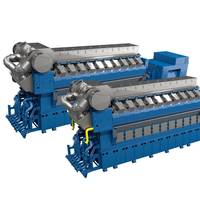Hydrogen As an Energy Carrier
Hydrogen can play a significant role in decarbonizing world energy supply to mitigate climate change, according to a new research paper by DNV GL, the technical advisor to the oil and gas industry.According to new DNV GL research paper, decarbonization could drive an estimated 100,000-fold rise in demand for hydrogen for energy by 2050. The paper lays out a viable business concept for producing low-carbon transportable hydrogen offshore from natural gas.'Hydrogen as an energy carrier' predicts demand for hydrogen for heating residential and commercial space, heat for industry, and transport to reach between 39 and 161 million tonnes of hydrogen per annum (Mtpa) in 2050, under various modelled scenarios.
Rolls-Royce Unveils New Medium Speed V-Engines

Rolls-Royce has launched a V-line version of the new B33:45 liquid fuel and B36:45 gas engine series, completing the engine lineup following the launch of the first variants three years ago.The V-line will consist of 12-, 16- and 20-cylinder variants, while the inline platform is available in 6-, 8- and 9-cylinder. At 600 KW per cylinder the new engines offer a 20 percent increase in power per cylinder compared to their predecessors. Rolls-Royce said the engines set offer exceptionally low fuel consumption and emissions of NOx…
New Report on Norwegian Energy Policy

Norway is pursuing ambitious, forward-thinking energy policies, but could go further in its efforts to become a low-carbon economy, the International Energy Agency (IEA) has concluded in a review published today. Energy Policies of IEA Countries - Norway 2011 Review says that it will be challenging for Norway to meet its 2020 target of reducing greenhouse gas emissions by 30% compared with 1990 levels, because both the country’s electricity supply and its energy use in buildings are already essentially carbon-free due to hydropower use.





